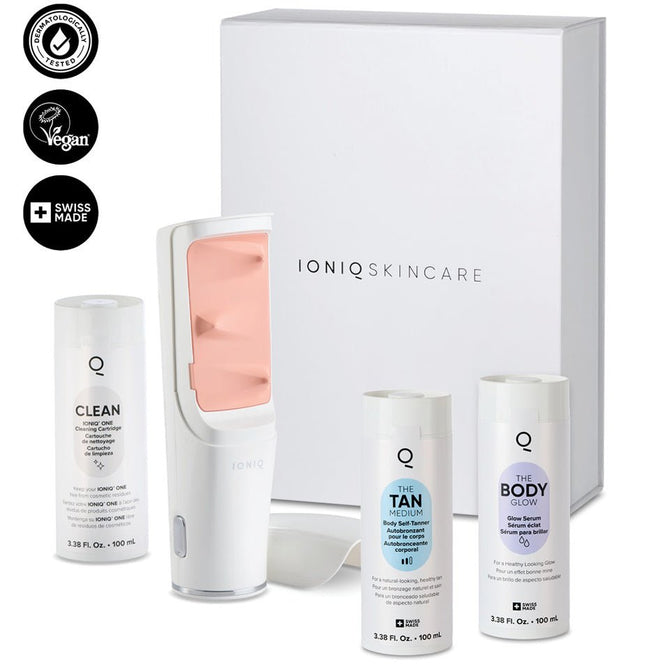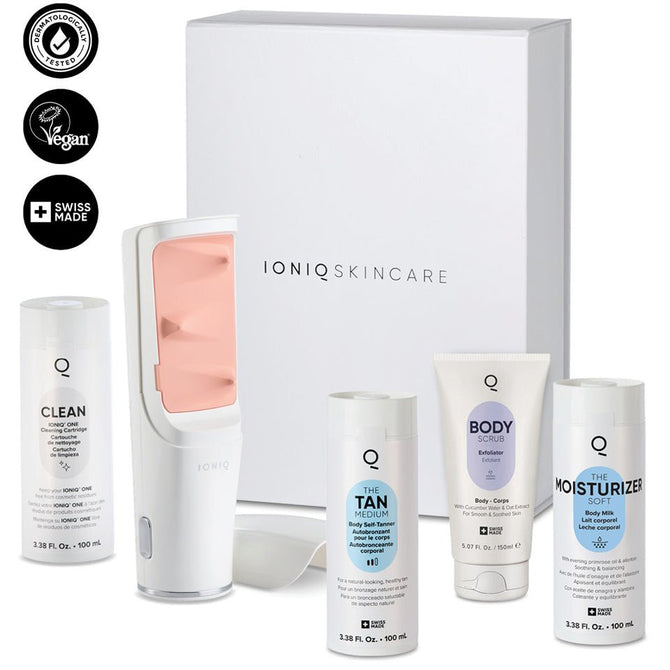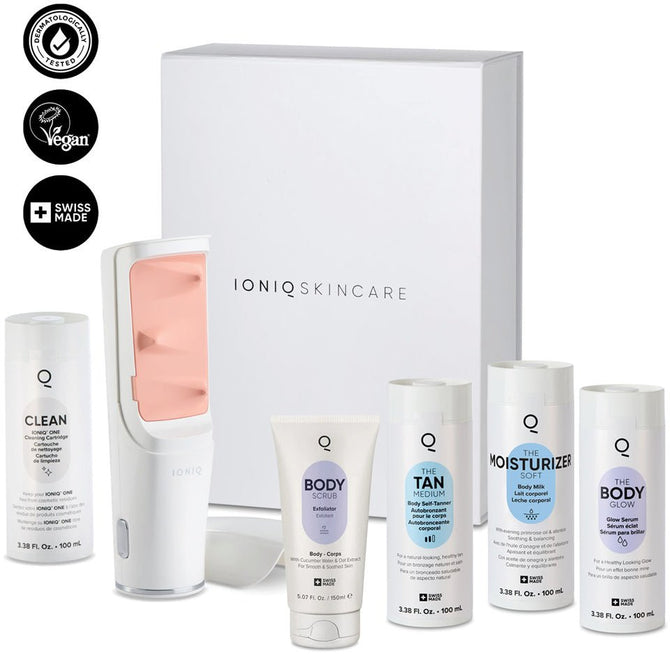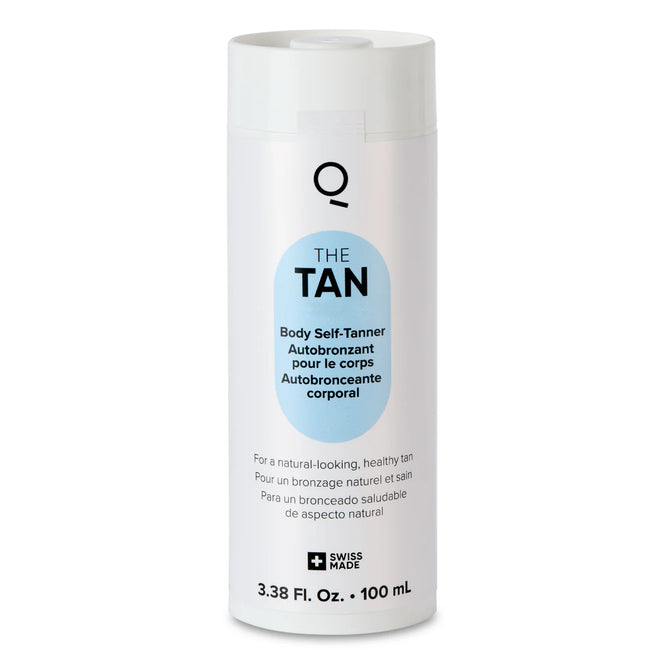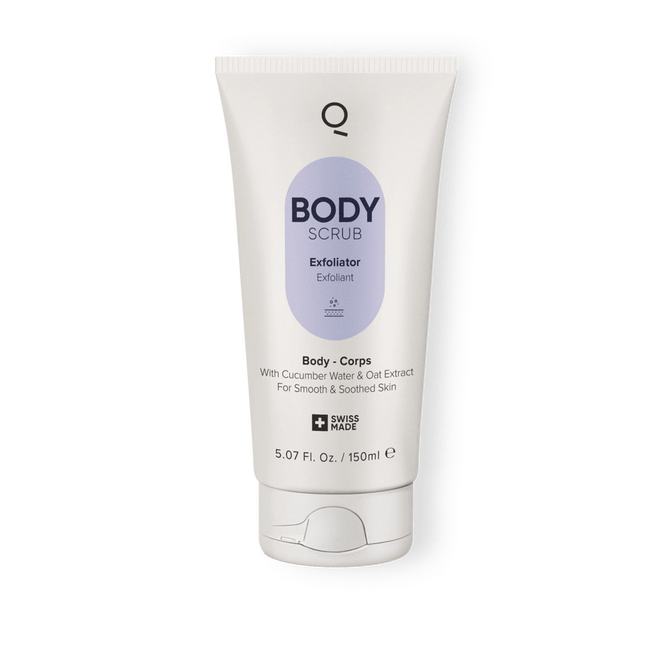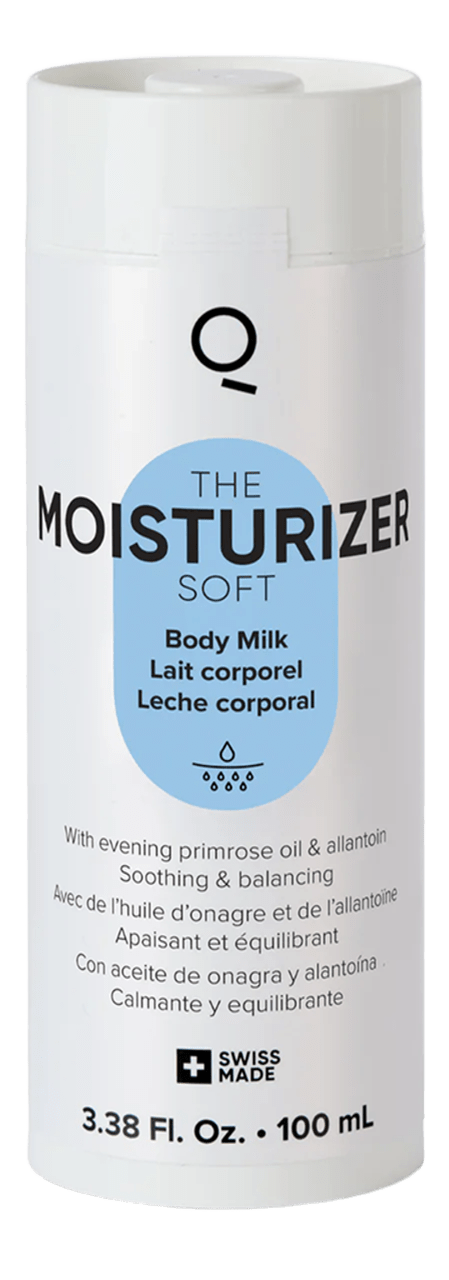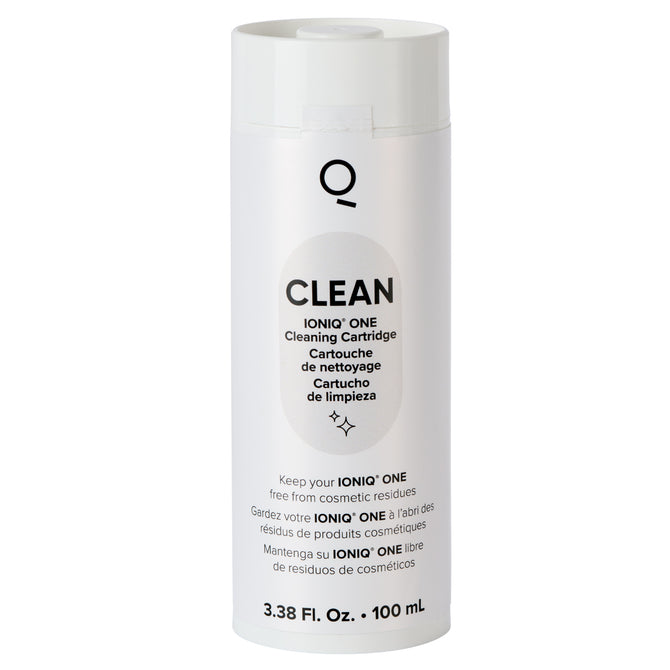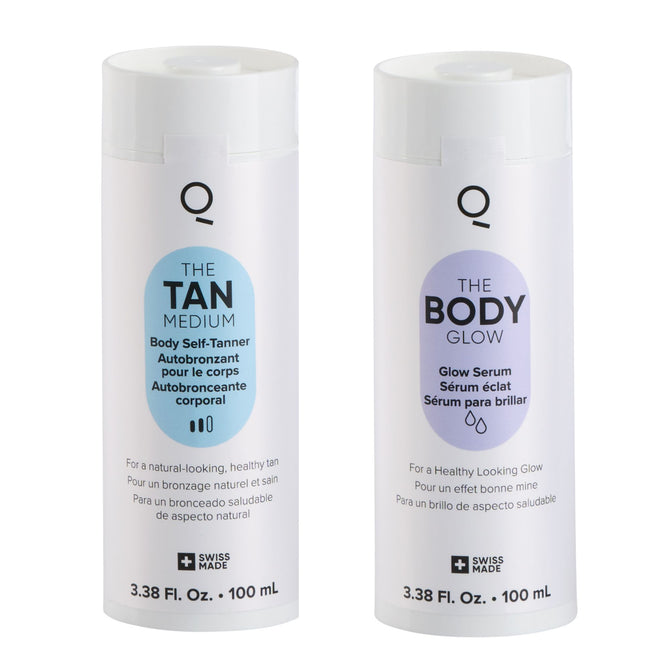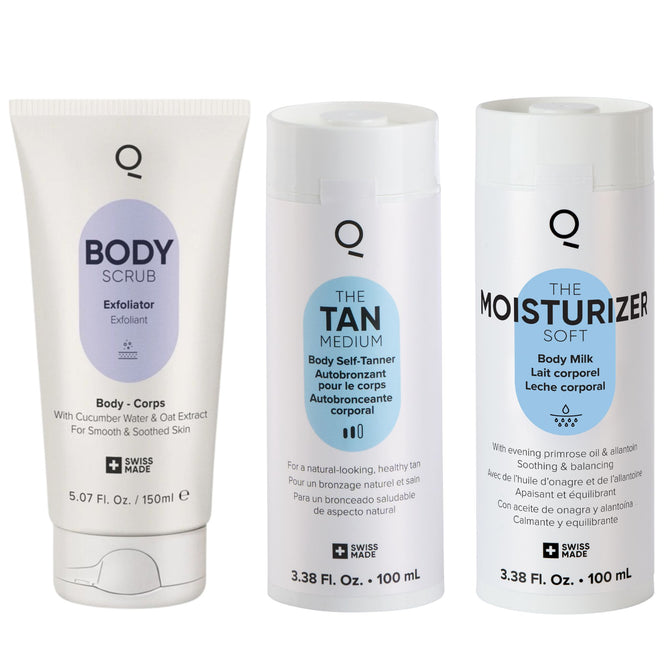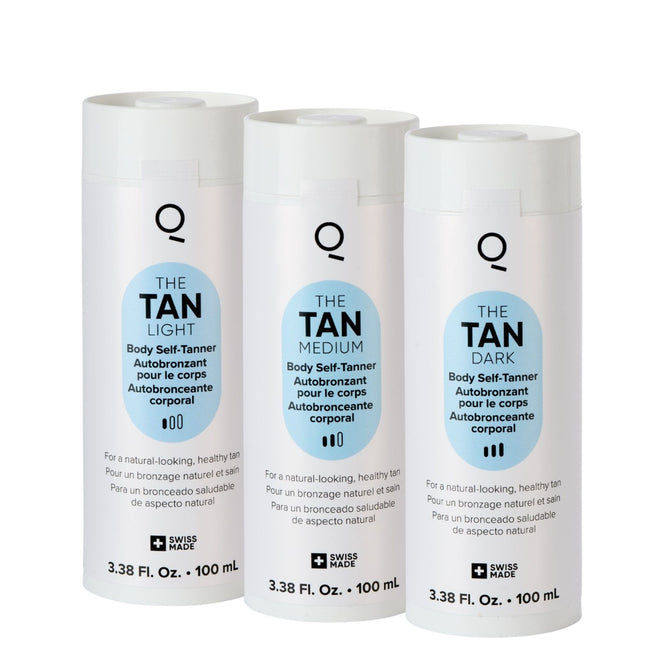
Sun-kissed skin never goes out of style—but how you get that glow matters. With so many options available today, from a quick self-tanner at home to a professional spray tan at a salon, it’s easy to feel overwhelmed. You’ve probably found yourself endlessly Googling terms like “self-tanner vs. spray tan” or “spray tan vs. self-tanner,” hoping to land on the perfect answer. Should you book a professional appointment or trust your favorite self-tanner for a DIY bronze? Is investing in a spray tan really worth the extra cost, or can a quality self-tanner from your local store deliver comparable results?
Whether you're aiming for a quick glow-up before a weekend event or a longer-lasting bronze for vacation, understanding the difference between a professional spray tan and at-home self-tanner is key. And while many self-tanners claim salon-quality results, IONIQ ONE Sprayer + TAN is in a league of its own—a revolutionary, contactless spray system that combines the evenness of a pro spray tan with the convenience of at-home use. It's not just another self-tanner; it's a category-defining innovation.
In this guide, we’ll break down everything you need to know about the self-tanner vs. spray tan debate—from convenience and cost to color payoff and customization. We’ll even show you how to combine both techniques to extend your tan and keep your skin looking radiant. Let’s dive in!
History and Evolution of Tanning Methods
Tanning has been an essential part of beauty and culture for centuries. From ancient civilizations to the present day, the desire for a bronzed glow has led to the evolution of various tanning methods. What began as sunbathing and risky outdoor exposure has transitioned into safer, more efficient ways to achieve that coveted beachy glow look.
The Rise of Self-Tanning Products
By the late 20th century, awareness of the harmful effects of prolonged sun exposure began to spread. As the skin cancer epidemic rose, people began to seek safer alternatives to sunbathing and tanning beds. Enter self-tanning products, which offer a beautiful tan without the risk of UV damage.
The first self-tanners were introduced in the 1960s, but it wasn’t until the 1980s that the formulas began to improve. Initially, self-tanners were often criticized for their unnatural orange hues, streaky finishes, and difficulty in application. However, as technology and formulations advanced, these products became more user-friendly and effective.
Traditional self-tanners work by using a chemical called dihydroxyacetone (DHA), which interacts with the amino acids in the skin to create a temporary, sunless tan. Over time, regular self-tanners evolved to offer a more natural-looking finish, with more skin-friendly ingredients and more sophisticated formulas. With this shift, self-tanning became an increasingly popular choice for those looking to achieve a golden glow without the risks associated with UV exposure.
In recent years, the demand for safer, at-home alternatives has surged, and the industry has responded with innovative, user-friendly products. One of the most groundbreaking advancements in tanning technology is the IONIQ ONE Sprayer + TAN, which stands far above all other tanners. This product marks a significant turning point in the evolution of tanning methods, revolutionizing the way people achieve a sunlit glow at home.
What is a Professional Spray Tan?
A professional spray tan uses UV-free solutions to give you a smooth, radiant bronze without the harmful effects of tanning beds or sun exposure.
How It Works: Airbrush or Booth Application by a Technician
Salons typically offer two types of spray tans: airbrush tanning and booth tanning. In an airbrush session, a trained technician applies the tanning solution—usually DHA-based using a handheld device—for a controlled application. However, it can be time-consuming and may feel less private for some clients.
In a booth spray tan, you step into an enclosed chamber where jets automatically distribute the solution. It’s a faster, more private option, but the lack of manual adjustment can lead to less precise coverage, particularly around joint areas or if you move incorrectly during the process.
Typical Spray Tan Process: Prep, 15-Minute Session, Results
To achieve good results from a professional spray tan, proper skin preparation is key. Exfoliating about 24 hours beforehand helps slough off dead skin cells and creates a smoother surface for even application. The tanning session itself typically takes 10 to 20 minutes. Afterward, you’ll need to wear loose, dark clothing to avoid smudging or staining as the solution develops.
While you’ll notice an immediate bronze tint, this is often just a guide color—the final tan usually develops fully within 24 hours. However, some clients may find the wait time and post-tan restrictions (such as avoiding water, sweating, or tight clothing) inconvenient or limiting.
Spray Tan Shades
Professional spray tans often allow for shade adjustments based on skin tone and event needs. Technicians can mix different concentrations to produce anything from a subtle glow to a deeper tan. Lighter tones may be chosen for everyday wear, while darker options are sometimes preferred for vacations or special events.
That said, the final color can depend on how your skin reacts to the formula, and even with customization, results aren’t always perfectly predictable.
What is a Self-Tanner?
A self-tanner is a UV-free product that you can apply right at home to achieve a bronzed look without stepping into the sun or booking a professional spray tan. Like a spray tan, a self-tanner relies on DHA (dihydroxyacetone), a sugar-derived compound that reacts with the amino acids in your skin to develop a temporary tan.
How Does Self-Tanner Work
Most at-home self-tanner products come in the form of creams, mousses, drops, or even fine mists that mimic a spray tan. These formulas contain DHA, just like in a professional setting, but are designed for DIY use. Once applied, DHA starts to react with your skin’s outer layer, producing a golden tan over the course of several hours. Depending on the product, your glow may appear within 1 to 6 hours and last for several days.
Typical Self-Tanner Process: Application, Gradual or Instant Color
Getting a tan with a regular self-tanner starts with proper prep. Just like with a spray tan, exfoliating beforehand helps create a smooth canvas, reducing the risk of streaks or patchiness. During application, use a mitt to evenly distribute mousse or cream products, and for drops, mix them into your favorite moisturizer to customize the depth of your tan. After applying the self-tanner, allow your skin to dry fully before getting dressed to avoid smudges or uneven development.
The biggest perk? You control the outcome. Want a subtle hint of color or a deeper bronze? Reapply your self-tanner over a few days to gradually deepen your tan—something not as easily done with a one-time professional spray tan.
Types of Self-Tanners
Self-tanner formulas are as diverse as your skincare routine:
-
Lotions: Hydrating and well-suited for dry skin, but they can feel heavy and take longer to dry—making product transfer more likely.
-
Mousses: Fast-drying and easy to apply, though they can cling to dry patches and highlight uneven texture without proper prep.
-
Sprays: Great for covering hard-to-reach spots like the back, but overspray and streaking are common without careful application or good ventilation.
-
Drops: Mix seamlessly with your favorite moisturizer for a custom tan, though uneven blending can cause patchy results.
-
IONIQ ONE Sprayer + TAN: The most advanced option. This smart sprayer uses Magnetic Skin Technology to deliver perfectly even, streak-free coverage —no rubbing, no guesswork, and zero UV exposure. It's non-drying, mess-free, and ideal for full-body application, even on hard-to-reach areas like the back. Unlike other formats, IONIQ ONE Sprayer + TAN combines precision, ease, and skin care in one device.
Skin Type Considerations for Self-Tanning
Different skin types react to spray tans and self-tanners in unique ways. Whether you have oily, dry, or sensitive skin, understanding how your skin type influences tanning can help you achieve a natural, long-lasting glow. In this section, we’ll explore how each skin type reacts to various tanning methods and provide tailored tips on how to prep your skin for the best results.
Oily Skin:
Oily skin can pose challenges when it comes to self-tanning. Excess oil can interfere with the absorption of tanning products, leading to uneven results. If you have oily skin, regular self-tanners may slide off your skin or develop uneven patches.
Tips for prepping oily skin for tanning:
-
Exfoliate well: Use a gentle exfoliant to remove excess oil and dead skin cells. This helps the tanning product apply more evenly.
-
Avoid heavy moisturizers: Oily skin doesn’t need a lot of extra moisture. Use a lightweight, oil-free moisturizer if necessary, but avoid greasy products.
-
Choose an oil-free self-tanner: Many self-tanning products are specifically formulated for oily skin, offering better adherence and even results.
Dry Skin:
Dry skin tends to absorb tanning products more quickly, but it can also lead to patchiness or streaks, especially in drier areas like elbows, knees, and ankles. The key to achieving a smooth tan on dry skin is ensuring your skin is well-prepped and properly moisturized.
Tips for prepping dry skin for tanning:
-
Exfoliate gently: Use a hydrating scrub to remove dead skin cells without irritating your skin. Dry skin can be more sensitive, so avoid harsh scrubs.
-
Moisturize before tanning: Apply a rich, hydrating lotion to the skin, focusing on dry areas. This helps create a smooth base for the self-tanner to adhere to.
-
Use a hydrating self-tanner: Look for self-tanners with aloe, glycerin, or other hydrating ingredients to keep your skin moisturized while tanning.
Sensitive Skin:
Sensitive skin can be particularly tricky when it comes to tanning products. Many regular self-tanners contain chemicals or fragrances that can irritate delicate skin. However, with the right precautions, sensitive skin can still enjoy a beautiful tan without the discomfort.
Tips for prepping sensitive skin for tanning:
-
Patch test first: Always test a small amount of self-tanner on a discreet area of your skin to ensure you don’t have an adverse reaction.
-
Choose a gentle self-tanner: Opt for a vegan, cruelty-free, and paraben-free formula to minimize the risk of irritation.
-
Hydrate your skin: Keeping sensitive skin well-moisturized can help prevent irritation during the tanning process.
Why IONIQ Stands Out Among Alternatives
Unlike many traditional self-tanning products, IONIQ ONE Sprayer, the best at-home spray tan offers a unique formulation and delivery system that makes it a superior choice for all skin types—especially those that struggle with conventional tanners.
For oily skin, IONIQ ONE Sprayer + Tan is remarkably lightweight and non-comedogenic, meaning it won’t clog pores or leave behind a greasy residue. Its ultra-fine spray technology ensures even coverage without build-up, which is key for oil-prone skin that tends to repel heavy formulas.
What sets IONIQ ONE Sprayer apart even further is its skin-friendly composition. With natural ingredients like panthenol (pro-vitamin B5), aloe vera, and glycerin, the formula not only tans but also nourishes and hydrates. These components make it exceptionally compatible with dry and sensitive skin, offering a smooth application and minimizing the risk of irritation.
Unlike many self-tanners that rely on synthetic fragrances and harsh preservatives, IONIQ prioritizes a clean, gentle formula that adapts to your skin’s needs. Whether your skin is oily, dry, or sensitive, it delivers a natural, streak-free tan without compromise.
Let’s Settle the Spray Tan vs. Self-Tanner Debate (Spoiler: One Clearly Wins)
Whether you're prepping for a special event or just looking to maintain a healthy glow, deciding between a professional spray tan and an at-home self-tanner comes down to cost, convenience, and control. Here's a clear breakdown to help you make the smartest choice for your skin and lifestyle.
1. Cost
-
Spray tan: Typically costs $65 per session, depending on location and customization.
-
Self-tanner: Priced between $50 and $500 per bottle, with each bottle providing multiple applications.
Winner: Self-tanner
The long-term savings are significant. A single bottle delivers weeks of color, making self-tanner a far more budget-friendly option for regular use.
2. Convenience
-
Spray tan: Requires booking appointments, traveling to the salon, and planning around development time.
-
Self-tanner: Apply anytime at home, on your own schedule, without the need to leave the house.
Winner: Self-tanner
Traditional self-tanners offer unmatched flexibility—ideal for spontaneous plans, busy schedules, or anyone who prefers low-maintenance beauty routines.
3. Results
-
Spray tan: Offers expert application with smooth, even results and minimal streaking.
-
Self-tanner: With modern formulas and proper technique, results can rival or even match a salon finish.
Winner: Self-tanner
While beginners may need a learning curve, quality self-tanners now deliver professional-looking results at home.
4. Longevity
-
Both: Results typically last 5 to 7 days, depending on skin prep and aftercare.
Tie
With good exfoliation and moisturizing, both tanning methods offer similar staying power.
IONIQ ONE Sprayer + TAN, an at-home spray tan system stands out by offering up to 9 days of flawless tan longevity—longer than both traditional spray tans and most self-tanners. Plus, unlike other methods that require meticulous preparation, IONIQ ONE Sprayer + TAN provides natural results without needing to worry about extensive skin prep.
5. Customization
-
Spray Tan: Technicians can match your skin tone and adjust the shade, but mistakes can still happen. If the technician isn’t careful or the equipment isn’t set right, you might get a tan that's too dark or uneven.
-
Self-tanner: Many traditional self-tanners offer adjustable tones and buildable coverage, but it’s easy to overdo it. If you apply too much, you might end up with a dark or streaky tan, and there’s no technician to fix it.
Tie
While spray tans provide expert color matching, self-tanners allow for ongoing customization and experimentation at home.
6. Safety
-
Both: Free of UV radiation and considered safe when used as directed.
Tie
Both options are sunless and safe, making them healthier alternatives to tanning beds or sunbathing.
Final Verdict: Self-Tanner Wins Overall
Professional spray tans come at a higher cost and require more time and planning. Self-tanners, on the other hand, are cost-effective, convenient, and capable of delivering equally impressive results with a bit of practice. For everyday use and long-term tanning, self-tanner is the smarter, more sustainable choice.
Some people believe professional spray tans and salon-based services like tanning booths offer quick, flawless results—but in reality, the downsides often outweigh the hype. Frequent salon visits mean recurring costs, awkward appointment scheduling, and inconvenient aftercare routines. And despite promises of perfection, results can still fade unevenly or turn patchy after just a few days.
Traditional salon methods also raise concerns about hygiene, UV exposure, and privacy—especially in shared environments. Whether it’s the risk of hidden cameras in tanning rooms or the inconsistent cleanliness of equipment, many find the experience far from relaxing.
Why Modern Self-Tanners Win
Traditional self-tanners have come a long way. Today’s best formulas offer natural-looking color, skin-friendly ingredients, and full control over application—all without leaving your home. And while there’s a learning curve with regular products like mousses or lotions, the payoff is convenience, affordability, and peace of mind.
But IONIQ ONE Sprayer + TAN isn’t just another self-tanner—it’s in a class of its own. This award-winning sprayer delivers even, streak-free color.
The Bottom Line
Salon tans may seem like a quick fix, but the cost, hassle, and potential risks quickly add up. In contrast, at-home solutions, for example, IONIQ ONE Sprayer + TAN combine safety, consistency, and personalization—without compromising results. It’s the smarter, more advanced way to glow year-round, with none of the downsides of salon tanning.
Professional Spray Tan vs. Self-Tanner: Which Should You Choose?
Deciding between a professional spray tan and a traditional self-tanner ultimately comes down to your lifestyle, budget, and how much control you want over your glow. Both options offer a UV-free tan, but they cater to different needs.
Pick a self-tanner if you’re working with a tighter budget or prefer the flexibility of at-home tanning. A good self-tanner allows you to build and maintain your glow weekly without the cost of recurring spray tan sessions. If you enjoy experimenting with beauty products and don’t mind taking a bit of time to learn how to apply your tanner evenly, a self-tanner can deliver impressive results. Plus, it’s a great option if you want to maintain your tan between professional appointments or extend the life of your spray tan.
FAQs About Self-Tanner vs. Spray Tan
Navigating the world of self-tanners and professional spray tans can leave you with plenty of questions—especially if you’re aiming for a natural-looking tan without the trial and error. Below are answers to the most common questions about professional spray tans and at-home tanner options, so you can glow with confidence.
Does a Professional Spray Tan Last Longer Than Self-Tanner?
Not necessarily. With proper prep and aftercare, both a professional spray tan and traditional self-tanner can last between 5 to 7 days. The longevity of your tan in this case depends more on exfoliation, hydration, and avoiding things like long hot showers or chlorinated pools. However, IONIQ’s advanced formula and fine mist application can extend your tan’s life even further—lasting up to 9 days—making it one of the most durable and low-maintenance options available.
Can You Use a Regular Self-Tanner After a Spray Tan to Touch Up?
Yes—and it’s actually a great strategy. As your spray tan begins to fade, certain areas like knees, elbows, and hands may lose color faster. Applying a self-tanner to those spots can help even out your tan and extend the results of your professional treatment. Just be sure to use a formula that blends easily and matches your current tan level.
Is a Spray Tan Safer Than Sunbathing?
Absolutely. Both self-tanner and professional spray tan methods are UV-free, making them significantly safer than sunbathing or tanning beds. UV exposure from the sun is linked to premature aging, sunspots, and skin cancer. A professional spray tan or a high-quality self-tanner gives you a bronzed glow without putting your skin at risk.
How Do I Make My Self-Tanner Look as Good as a Spray Tan?
Achieving professional spray tan-level results at home with a regular self-tanner is possible but it just takes the right prep and tools. Always exfoliate before applying your tanner to ensure an even surface, and use a mitt to avoid streaks or orange palms. Choosing a self-tanner with a guide color can also help you see where you've applied the product, making the application more foolproof. With a little practice, your at-home tan can rival a professional one.
The Best of Both Worlds: IONIQ ONE Sprayer + TAN
Why choose between a regular self-tanner and a professional spray tan when you can get the best of both worlds in one sleek device? The IONIQ ONE Sprayer + TAN system is designed to deliver spray tan perfection with the ease of at-home application—making it the ultimate solution for those who want flawless results without the salon hassle.
Achieve Professional Spray Tan Results at Home
-
Salon-quality mist technology: The IONIQ ONE Sprayer + TAN mimics the ultra-fine spray of a professional spray tan, giving you smooth, even coverage from head to toe—no streaks, no missed spots.
-
Magnetic Skin Sensors: Built-in sensors automatically adjust spray intensity to match your body’s curves, ensuring your tan looks seamless and natural in every area.
Whether you're new to self-tanner or a seasoned pro, the IONIQ ONE system offers salon-level results at your fingertips. It’s perfect for touch-ups between professional spray tan appointments or as your main tanning method year-round.
Skip the salon—get a flawless glow with IONIQ ONE Sprayer + TAN!
Final Thoughts: Glow Smarter, Not Harder
When it comes to achieving a golden, sun-kissed glow, traditional options like professional spray tans and regular self-tanners often require a trade-off—between convenience, control, and consistency.
But with the innovation of the IONIQ ONE Sprayer + TAN, those compromises are no longer necessary. Its smart spray technology delivers even, streak-free coverage with minimal effort, combining salon-quality results with true at-home ease. Now, getting a flawless tan doesn’t mean choosing between cost, time, or outcome—you can have it all, right from your bathroom.
So go ahead—glow your own way. Whether you’re bronzing for a big event or just want a little sunshine in your everyday life, the perfect tan is just a spritz or swipe away.




